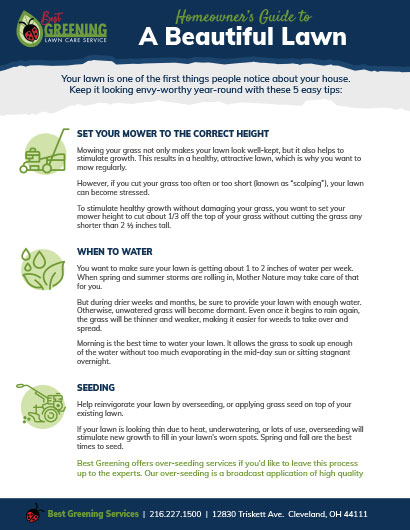Top 5 Summer Tips to Keep Lawn Green
By Rick Pietrick
In Ohio, our changing seasons can be extreme. A cool, wet spring can turn into a hot, dry summer in a matter of weeks. The ground dries up and along with it your nice green lawn. There are several factors that can turn a healthy, green lawn brown. The following 5 tips will help keep your lawn green through summer this year.
Turf type
Most all grass in Ohio is a variety of “cool-season grass.” Cool-season grasses prefer temperatures of 60 – 75 F. Being subjected to higher temperatures will stress the plant. Usually if the plant is healthy, it will be able to withstand the higher temps. However, if the plant is already stressed from drought, insect/disease, or mowing damage, the plant may not recover. It is important to know the turf types in your lawn so you can maintain accordingly. Most newer residential lawns are a mixture of Kentucky Bluegrass, Perennial Rye, and/or Fescue grass.
Proper mowing
This may be the most important aspect of a green lawn once we get into the heat of summer. Mowing damage can scorch your lawn beyond recovery, leaving burnt streaks in the pattern of your mowing passes. The worst part about mowing damage is that it is easily preventable.
To keep your lawn green through summer:
- Make sure you are mowing at a height no shorter than 3 – 3 1/2 inches.
- Never mow in the afternoon when the sun is at its hottest. The combination of heat alone can burn your lawn.
- Mow frequently. An industry rule of thumb is to never cut more than 1/3 of the grass blade off at any time. By mowing regularly, you can maintain your grass at a healthy length while still giving it a nice manicured look.
- Even with your mower set on high, if the grass is allowed to grow tall (5-8 inches), mowing at your regular setting could stress the plant because of the 1/3 rule.
Watering
Every living thing needs water to survive and your turf grass is no different. During the summer months, weeks can go by without rainfall. The turf plant begins to feel stressed and will go into an automatic shutdown mode to conserve energy. This is called dormancy. Your turf will appear brown or tan and may even be dry to touch. This is okay. It is a built-in defense mechanism to protect the plant against drought. It will most likely recover with cooler temperatures in early fall.
However, you can supplement the lack of rainfall by watering. If done properly, watering will prevent the plant from going dormant in summer. The best and most healthy way of watering is to mimic the natural patterns of rainfall.
Tip: Deep, infrequent soakings are better for your turf plant than watering every day. Watering 3-4 days a week with good soaking will encourage the turf plant to grow deep healthy roots, creating a greener plant.
Fertilizing and insect & disease monitoring
During summer months, the lawn still requires a food source to keep healthy levels of growth. Applying a slow-release fertilizer gives the plant a nutrient source while safeguarding against product burn from summer heat. This is also the time where insects and lawn disease become present. If you have splotches or brown spots that do not go away with proper watering, there may be an insect/disease problem. Many insects are active during the hot and dry months. If you have any concerns, a technician with Best Greening Services can help diagnose and treat the problem area.
Traffic
Wear and tear from traffic can take a toll on your lawn. Animals, workers, kids, or vehicles can damage the structure of the turf plant, turning it brown and eventually wearing it to bare dirt. Be aware of any areas that appear to be getting worn from traffic and avoid until the area recovers. Over-seeding in early fall is a good way to thicken (toughen up) the lawn for the next year and will help repair traffic damage from the summer.



